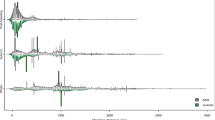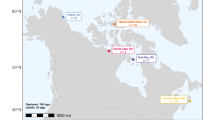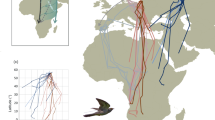Abstract
The orientation of two closely related subspecies of Australian silvereye Zosterops lateralis was studied in captivity over 14 months. Migratory silvereyes Z. lateralis lateralis showed significant directional preferences during the spring and autumn migration periods and also displayed orientated behaviour during the breeding period. In contrast, the non-migratory subspecies Z. lateralis familiaris did not display any significant directional preferences at any time. This is the first time that the orientation behaviour of a migratory and non-migratory subspecies has been compared over the duration of an annual cycle, both during and outside the migratory periods. The results suggest that migratory silvereyes possess an endogenous program determining the timing and direction of autumn and spring migration and that this program is unique to the migratory subspecies. This is also the first comparison of this nature on southern hemisphere birds and demonstrates that the migratory behaviour of southern hemisphere migrants may be more similar to that of northern hemisphere migrants than previously thought.

Similar content being viewed by others
References
Able KP, Able MA (1993) Daytime calibration of magnetic orientation in a migratory bird requires a view of skylight polarization. Nature 364:523–525
Able KP, Able MA (1997) Development of sunset orientation in a migratory bird: no calibration by the magnetic field. Anim Behav 53:363–368
Batschelet E (1981) Circular statistics in biology. Academic, London
Berthold P (1998) Bird migration: genetic programs with high adaptability. Zoology 101:235–245
Berthold P (2001) Bird migration: a general survey, 2nd edn. Oxford University Press, Oxford
Berthold P, Helbig AJ (1992) The genetics of bird migration: stimulus, timing and direction. Ibis 134:35–40
Berthold P, Pulido F (1994) Heritability of migratory activity in a natural bird population. Proc R Soc Lond B 257:311–315
Berthold P, Helbig AJ, Mohr G, Querner U (1992) Rapid microevolution of migratory behaviour in a wild bird species. Nature 360:668–669
Bingman VP, Wiltschko W (1988) Orientation of dunnocks (Prunella modularis) at sunset. Ethology 77:1–9
Bletz H, Weindler P, Wiltschko R, Wiltschko W, Berthold P (1996) The magnetic field as reference for the innate migratory direction in blackcaps, Sylvia atricapilla. Naturwissenschaften 83:430–432
Chan K (1994a) Nocturnal activity of caged resident and migrant silvereyes (Zosteropidae: Aves). Ethology 96:313–321
Chan K (1994b) Migratory fattening of in an Australian intracontinental migrant. Condor 96:211–214
Chan K (1995) Diurnal and nocturnal patterns of activity in resident and migrant silvereyes Zosterops lateralis. Emu 95:41–46
Chan K (2001) Partial migration in Australian landbirds: a review. Emu 101:281–292
Chan K, Kikkawa J (1997) A silvereye dilemma: to migrate or not to migrate? Emu 97:91–97
Chan K, Sutton P (1993) Migratory behaviour of silvereyes returning to Tasmania from southern Victoria. Corella 17:41–42
Cooke B, Munro U (2000) Orientation studies on the regent honeyeater, Xanthomyza phrygia (Melphagidae) and endangered bird of south-eastern Australia. Aust J Zool 48:379–384
Degnan SM, Owens IPF, Clegg SM, Moritz CC, Kikkawa J (1999) MtDNA, microsatellites and coalescence: tracing the colonization of silvereyes through the southwest Pacific. In: Adams NJ, Slotow RH (eds) Proceedings of the 22nd International Ornithological Congress, BirdLife South Africa, Johannesburg, pp 1881–1898
Dorst J (1961) The migration of birds. Heinemann, London
Emlen ST, Emlen JT (1966) A technique for recording migratory orientation of captive birds. Auk 83:361–367
Ford HA (1989) Ecology of Australian birds. Surrey Beatty and Sons, Chipping Norton
Gander J (1998) Silvereye autumn migration and the effects of radio transmitters. Honours thesis, University of Technology, Sydney
Glück E (1982) Locomotor activity of day-migrating finches. In: Farner DS, King JR (eds) Avian biology, vol 5. Academic, New York, pp 221–285
Griffioen R (1996) Investigations of bird movements using the Australian Bird Count: a pilot study based on the silvereye, Zosterops lateralis. Graduate diploma thesis, LaTrobe University, Bundoora
Griffioen PA (2001) Temporal changes in the distributions of bird species in eastern Australia. Ph.D. thesis, LaTrobe University, Bundoora
Griffioen PA, Clarke MF (2002) Large-scale bird-movement patterns evident in eastern Australian atlas data. Emu 102:99–125
Gwinner E (1996) Circadian and circannual programmed in avian migration. J Exp Biol 199:39–48
Gwinner E, Czeschlik D (1978) On the significance of spring migratory restlessness in caged birds. Oikos 30:364–372
Gwinner E, Wiltschko W (1978) Endogenously controlled changes in migratory direction of the garden warbler, Sylvia borin. J Comp Physiol A 125:267–273
Gwinner E, Wiltschko W (1980) Circannual changes in migratory orientation of the garden warbler, Sylvia borin. Behav Ecol Sociobiol 7:73–78
Helbig AJ (1991) Inheritance of a migratory direction in a bird species: a cross-breeding experiment with SE-and SW-migrating blackcaps (Sylvia atricapilla). Behav Ecol Sociobiol 28:9–12
Helbig AJ (1992) Ontogenetic stability of inherited migratory directions in a nocturnal bird migrant; comparison between the first and second year of life. Ethol Ecol Evol 4:375–388
Helbig AJ (1996) Genetic basis, mode of inheritance and evolutionary changes of migratory directions in paleartic warblers (Aves: Sylviidae). J Exp Biol 199:49–55
Helbig AJ, Berthold P, Wiltschko W (1989) Migratory orientation of blackcaps (Sylvia atricapilla): population specific shifts of direction during the autumn. Ethology 82:307–315
Helbig AJ, Berthold P, Mohr G, Querner U (1994) Inheritance of a novel migratory direction in central European blackcaps. Naturwissenschaften 81:184–186
Higgins PJ, Peter JM, Cowling SJ (2006) Handbook of Australian, New Zealand & Antarctic birds, vol 7, part B. Oxford University Press, South Melbourne
Keast A (1958) Races, colonization and migration in the silvereye. Gould League Notes 24:10–13
Keast A (1961) Bird speciation on the Australian continent. Bull Mus Comp Zool 123:305–495
Keast A (1968) Seasonal movement in the Australian honeyeaters (Meliphagidae) and their ecological significance. Emu 67:159–209
Ketterson ED, Nolan V Jr (1985) Intraspecific variation in avian migration: evolutionary and regulatory aspects. In: Rankin MA (ed) Migration: mechanisms and adaptive significance—contributions in marine science, vol 27. University of Texas at Austin, Port Aransas, pp 553–579
Ketterson ED, and Nolan V Jr (1990) Site attachment and site fidelity in migratory birds: experimental evidence from the field and analogies from neurobiology. In: Gwinner E (ed) Bird migration. Physiology and ecophysiology. Springer, Berlin Heidelberg New York, pp 117–129
Lane SG (1972) Tasmanian type silvereyes in New South Wales. Aust Bird Bander 10:33–34
Lane SG, Battam H (1971) Silvereye movement in eastern Australia. Aust Bird Bander 9:80–82
Macdonald JD (1973) Birds of Australia. A summary of information. AH and AW Reed, Sydney
Mack G (1932) Notes on the Australian form of the genus Zosterops. Emu 31:51–55
Matter F (2001) Classification and population composition of silvereyes, Zosterops lateralis, (Zosteropidae) at Mt. Annan Botanic Garden, Campbelltown, N.S.W. Honours thesis, University of Technology, Sydney
Mees GF (1969) A systematic review of the Indo-Australian Zosteropidae (part III). Zool Verh 102:1–390
Mees GF (1974) The migration of the Tasmanian race of the silvereye. Aust Bird Bander 12:51–54
Munro U (1992) The orientation and migration of the yellow-faced honeyeater, Lichenostomus chrysops (Meliphagidae), a day migrating bird from Australia. Ph.D. thesis, University of New England, Armidale
Munro U (1999) Adaptations to a migratory lifestyle—an Australian perspective. In: NR Slotow (ed) Proceedings of the 22nd International Ornithological Congress, BirdLife South Africa, Durban, pp 956–978
Munro U (2002) Life-history and ecophysiological adaptations to migration in Australian birds. In: Berthold P, Gwinner E, Sonnenschein E (eds) Avian migration. Springer, Berlin Heidelberg New York, pp 141–154
Munro U, Munro JA (1998) Migratory restlessness in the yellow-faced honeyeater Lichenostomus chrysops (Meliphagidae), an Australian diurnal migrant. Ibis 140:599–604
Munro U, Wiltschko W (1992) Orientation studies on yellow-faced honeyeaters Lichenostomus chrysops (Meliphagidae) during autumn migration. Emu 92:181–184
Munro U, Wiltschko W, Ford HA (1993) Changes in the migratory direction of yellow-faced honeyeaters, Lichenostomus chrysops (Meliphagidae), during autumn migration. Emu 93:59–62
Munro U, Wiltschko R, Wiltschko W (1994) A comparison of migratory orientation of birds living in the northern and the southern hemisphere. Ring 16:5–15
Munro U, Munro JA, Phillips JB, Wiltschko W (1997a) Effect of wavelength of light and pulse magnetization on different magnetoreception systems in a migratory bird. Aust J Zool 45:189–198
Munro U, Munro JA, Phillips JB, Wiltschko R, Wiltschko W (1997b) Evidence for a magnetite-based navigational ‘map’ in birds. Naturwissenschaften 84: 26–28
Munro U, Funnell JR, Thomson, AS (2006) Moult in captive partially migratory and sedentary silvereyes (Zosterops lateralis) (Zosteropidae). J Ornithol 147:287–297
Nou S (2002) Molecular sex determination and population composition of sedentary and migratory silvereyes Zosterops lateralis (Latham 1801). Honours thesis, University of Technology, Sydney
Palmgren P (1934) Die Einwanderung des Teichrohrsängers, Acrocephalus s scirpaceus (Herm.), in Finnland. Ornis Fenn XI 4:77–484
Rowley I (1974) Bird life. Collins, Sydney
Schneider T, Thalau H, Semm P, Wiltschko W (1994) Melatonin is crucial for the migratory orientation of pied flycatchers (Ficedula hypoleuca Pallas). J Exp Biol 194:255–262
Skelton S (2003) Analysis of genetic diversity, population composition and body condition of silvereyes Zosterops lateralis (Zosteropidae: Aves) at Mt. Annan Botanic Gardens, NSW. Honours thesis, University of Technology, Sydney
Swanson N (1968) Suburban silvereyes. Aust Bird Bander 6:5–7
von Haartman L (1945) Zur Biologie der Wasser-und Ufervögel im Schärenmeer Südwest-Finnlands. AZF 44:128
von Haartman L (1952) Über ungepaarte Männchen in Grenzpopulationen der Kleinvögel. Acta Soc Fauna Flora Fenn 69:1–28
Wiltschko W, Gwinner E (1974) Evidence for an innate magnetic compass in garden warblers. Naturwissenschaften 61:406–407
Wiltschko W, Wiltschko R (1996) Magnetic orientation in birds. J Exp Biol 199:29–38
Wiltschko W, Wiltschko R, Emlen ST, Demong NJ (1980) Nocturnal activity and orientation behaviour during spring migration and early summer in the indigo bunting, Passerina cyanea. J Comp Physiol A 137:47–49
Wiltschko W, Munro U, Ford H, Wiltschko R (1993a) Magnetic inclination compass: a basis for the migratory orientation of birds in the northern and southern hemisphere. Experientia 49:167–170
Wiltschko W, Munro U, Ford H, Wiltschko R (1993b) Red light disrupts magnetic orientation of migratory birds. Nature 364:525–527
Wiltschko W, Munro U, Beason RC, Ford H, Wiltschko R (1994) A magnetic pulse leads to a temporary deflection in the orientation of migratory birds. Experientia 50:697–700
Wiltschko W, Wiltschko R, Munro U, Ford H (1998a) Magnetic versus celestial cues: cue-conflict experiments with migrating silvereyes at dusk. J Comp Physiol A 182:521–529
Wiltschko W, Munro U, Ford H, Wiltschko R (1998b) Effect of a magnetic pulse on the orientation of silvereyes Zosterops l. lateralis, during spring migration. J Exp Biol 201:3257–3261
Wiltschko W, Wiltschko R, Munro U (2000) Light-dependant magnetoreception in birds: does directional information change with light intensity? Naturwissenschaften 87:36–40
Wiltschko W, Munro U, Wiltschko R, Kirschvink JL (2002) Magnetite-based magnetoreception in birds: the effect of a biasing field and a pulse on migratory behaviour. J Exp Biol 205:3031–3037
Zar JH (1974) Biostatistical analysis. Prentice-Hall, Englewood Cliffs
Acknowledgements
This project was supported by an ARC Large grant to U.M. We thank Alan Leishman, Kathleen McCloskey, Alan Fletcher, Francoise Matter, Sirena Wan, Audrey Thomson, Esther Rosner and Boris Kosnowski for their support in catching and maintaining the birds in captivity. We also thank the technical, workshop and the security staff from the UTS Gore Hill and Kuring-gai Campus for their assistance. Peter Berthold, one anonymous reviewer and Wolfgang Wiltschko provided helpful comments to earlier versions of this paper. The experiments comply with the current laws of Australia.
Author information
Authors and Affiliations
Corresponding author
Additional information
Communicated by W. Wiltschko
Submitted to Behavioral Ecology and Sociobiology: 23 Jan 2006.
Rights and permissions
About this article
Cite this article
Funnell, J.R., Munro, U. Orientation in captive migratory and sedentary Australian silvereyes Zosterops lateralis (Zosteropidae). Behav Ecol Sociobiol 61, 337–345 (2007). https://doi.org/10.1007/s00265-006-0262-5
Received:
Revised:
Accepted:
Published:
Issue Date:
DOI: https://doi.org/10.1007/s00265-006-0262-5




